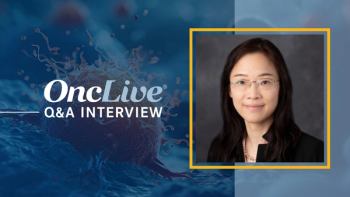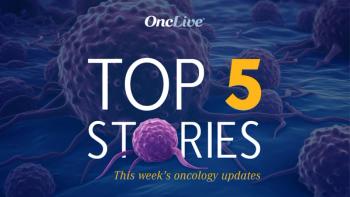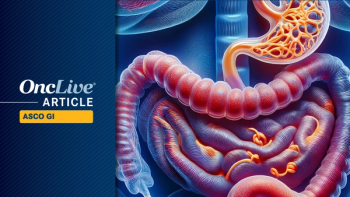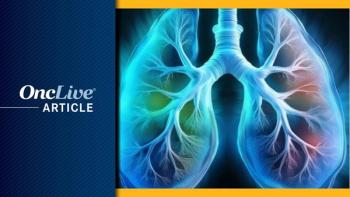
Emerging Targeted Therapies Emphasize Need for Molecular Testing in Lung Cancer
Benjamin P. Levy, MD, discusses emerging oncogenic markers in lung cancer and what impact they are poised to make on the paradigm.
Benjamin P. Levy, MD
With new targeted therapies continuing to emerge for biomarkers outside of EGFR and ALK, Benjamin P. Levy, MD, said that every patient with lung cancer should undergo comprehensive genomic testing upon diagnosis to ensure they are receiving the best-tailored treatment for their disease.
“There are actionable mutations outside of EGFR and ALK that we need to test for. We need to test for ROS1, BRAF V600E, RET, MET exon 14 skipping mutation, and KRAS G12C. We need to do comprehensive genomic profiling on all of our patients,” said Levy. “Next-generation sequencing (NGS) allows us to pick up on the mutations and the fusions, so it has to be a large panel. We also need to consider doing liquid biopsies on all of our patients so that, in the event that tissue misses these actionable mutations, we are able to detect them in the plasma.”
In an interview with OncLive during the 2020 Winter Lung Cancer Conference, Levy, an associate professor at Johns Hopkins School of Medicine and clinical director for the Johns Hopkins Sidney Kimmel Cancer Center at Sibley Memorial Hospital, discussed emerging oncogenic markers in lung cancer and what impact they are poised to make on the paradigm.
OncLive: What are the current molecular drivers being tested for in lung cancer?
Levy: The precision medicine story in lung cancer begins with EGFR- and ALK-directed therapies. What we have learned over the past 24, 36, and 48 months is that there are other driver mutations that are actionable and that we can offer target therapies for, including ROS1, RET, BRAF, NTRK, MET exon 14 skipping mutations, and KRAS G12C. It's an exciting time and it really underscores the importance of doing comprehensive genomic profiling for your patients.
How have biomarkers evolved in lung cancer?
We have started to have a firmer understanding of the genomic underpinnings of the tumor. This all started with the EGFR story in lung cancer that then evolved into ALK. More recently, we have learned that there are other actionable mutations that, while maybe less frequent than EGFR and ALK, are still as actionable.
There are other driver mutations, such as RET rearrangements, NTRK fusions, and MET exon 14 skipping mutations. All of these are incredibly important to identify because if we can identify them, we can deliver genotype-directed therapy. This is not a one-size-fits-all model in non—small cell lung cancer (NSCLC). We have to parse out lung cancer into distinct genomic subsets and then wed these subsets to particular targeted therapies that will most likely outperform chemotherapy.
Could you highlight some of the available treatment options for patients with oncogenic drivers?
Outside of EGFR and ALK, the first space that has witnessed a lot of traction is ROS rearrangements, or ROS1 fusions. We know that crizotinib (Xalkori) is a drug for ROS1 fusions, but more recently there were data with ceritinib (Zykadia) and now with entrectinib (Rozlytrek), lorlatinib (Lorbrena), and repotrectinib (TPX-0005). These 3 new drugs, when used as single agents in treatment-naïve patients with ROS1-positive NSCLC, result in response rates north of 70% to 80%, as well as a median progression-free survival of 19 to 20 months. That is pretty incredible.
More recently, we have learned that some of these drugs may have activity in patients who have already received crizotinib; lorlatinib and repotrectinib are 2 drugs that have been looked at [in the relapsed/refractory setting]. [Lorlatinib and repotrectinib] have shown activity in patients who have been on crizotinib and then their tumors progressed. We're learning about ROS1 the same we learned about ALK, which is that we're trying to learn how to sequence these drugs, including which is the optimal drug to give first and then second. For now, crizotinib or entrectinib are 2 first-line options for patients with ROS1 rearrangements, but other drugs may be active in the refractory setting.
There are other genotypes outside of ROS1 that are important, like MET exon 14 skipping mutations. This is a mutation that occurs in around 3% of patient with lung adenocarcinoma. Crizotinib has been somewhat the standard of care for these patients, but we have new data now with capmatinib and tepotinib—2 newer targeted therapies—that are working quite well for these patients in small numbers.
NTRK fusions, which are tissue-agnostic molecular markers, are prevalent in lung cancer. NTRK fusions are rare at 1%, but we have drugs, such as larotrectinib (Vitrakvi) and entrectinib, that are approved for NTRK fusions.
We thought KRAS G12C mutations were undruggable and we now have several drugs, including AMG 510, which is showing really competitive response rates and well tolerability of the drug, which is changing the game.
Overall, the story really is starting to evolve and underscores the importance of molecular testing for all patients. Comprehensive genomic profiling is critical to identify these actionable mutations beyond ALK and EGFR.
How and when should patients receive molecular testing?
The diagnostic algorithm and the testing strategies are evolving similarly to all these mutations that we're finding. The message clearly is comprehensive genomic profiling for all patients with advanced adenocarcinoma of the lung with a consideration to test for squamous cell patients that are never-smokers or light-smokers. People ask, "What type of testing is being done?" NGS, or comprehensive genomic profiling, that identifies all these mutations from EGFR, MET exon 14 skipping, KRAS G12C, and all of the rearrangements is critical. Tissue testing is important for all of our patients upfront prior to delivering the therapy.
I will make a pitch also for plasma genotyping or liquid biopsies. As hard as we try to identify all these molecular alterations in tissue, we miss some of them or the tissue is insufficient. Because of that, layering in the liquid biopsy at the same time may enhance your ability to capture these actionable mutations. In our practice, most patients get a tissue biopsy, but many of them have insufficient tissue or there's a delay in [getting the results back]. Therefore, we will perform the liquid biopsy at the same time. We have good data now to suggest you can do both. By doing both, you're going to be able to have a higher chance of picking up on the actionable mutations that will allow you to deliver the right therapy for the patient.
Do you recommend repeat testing?
Repeat testing at diagnosis is important in some ways. If you do a tissue biopsy and it's insufficient, and your liquid biopsy is also inconclusive or the patient does not shed circulating tumor DNA, one should consider going back and doing another biopsy. Retesting is important for treatment-naïve patients. If you are suspicious of an actionable mutation and you can't find it, my rule of thumb is, "Leave no gene behind." You have to test and look hard for these genetic alterations so [patients] can get the right therapy.
The other strategy [for repeat testing] is upon resistance. When patients on a genotype-directed therapy, such as osimertinib (Tagrisso) in the EGFR-positive space or alectinib (Alecensa) in the ALK-positive space progress, what do we do? We're still trying to answer that question, but repeat testing, either by a tissue biopsy or liquid biopsy, is helping. There are pros and cons to each [method]. Specifically, for EGFR-positive patients who are experiencing disease progression, it may be important to do a tissue biopsy if you're suspicious for small cell transformation, but oftentimes we will do both types of biopsy.
The workup for the diagnostic strategy that you want to implement in that setting is individualized. Liquid biopsies may be able to detect mechanisms of resistance. The largest body of data that we have about osimertinib resistance upfront for EGFR-positive patients who are treated initially with osimertinib and then progress, or whose tumors grow, come from plasma. That that should be a consideration when patients are experiencing disease progression on targeted therapy.
What other biomarkers are currently being investigated in lung cancer?
There are a lot. We're just starting to learn about these emerging biomarkers that will soon have approved targeted therapies. For MET exon 14 skipping mutations, there are 2 new drugs that are being looked at: capmatinib and tepotinib. For RET fusions, we've got a wonderful drug with selpercatinib (LOXO-292), which has shown a response rate north of 70%. For KRAS G12C mutations, [AMG 510] is an oral therapy that's eliciting response rates north of 40% to 50%. These are emerging biomarkers that will soon have approved therapies.
The real understanding of tumor biology leads to the better tailored therapies that lead to better outcomes, in turn, for patients. We will see drug approvals for all of these genotypes within the next 12 to 24 months, and I'm really excited. It's a fascinating time to be in the field of lung cancer and see precision medicine really at work for these patients.
How has the search for biomarkers and the creation of targeted therapies impacted lung cancer treatment?
We are in a new field of thoracic oncology. The word is out that we're on the leading edge of precision medicine. Testing for these alterations, while rare, when you find them and you're able to deliver a targeted therapy, it's a meaningful impact for a patient that goes far beyond what chemotherapy can do for that patient. You can't give the drug unless we know the target. I tell my patients all the time, “I can't give you the drug unless I know your particular gene.” The only way I can detect that gene is by doing tissue and plasma. The saying is, "Test; don't guess." That is really important; leave no gene behind. You have to look hard for all of these genes. There are too many genes of interest now that have potential targeted therapies that make a real meaningful impact for patients.

























































































